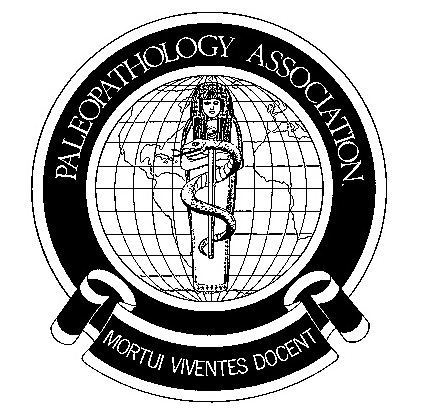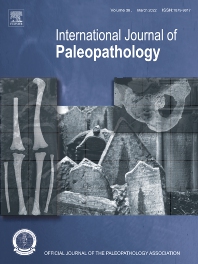| PALEOPATHOLOGY ASSOCIATION FOUNDED IN 1974 |
INTERNATIONAL JOURNAL OF PALEOPATHOLOGYThe International Journal of Paleopathology (IJPP) carves out a dedicated academic space for communication, collaborations and cutting-edge research in paleopathology - human and non-human. The journal seeks to encourage research and foster interdisciplinary communication. The IJPP accepts submissions towards Special Issues reflecting key themes within paleopathology, along with research articles, case-studies of impact, brief communications, and technical notes. Editor-in-Chief: Anne L. Grauer Associate editors: Simon Mays, Efthymia Nikita, Ana Luisa Santos, Dong Hoon Shin, Richard Thomas, Anne Teitelbaum |
|
Volume 50 is in progress!
Check out the latest published papers here
Volume highlightsWHAT ARE VOLUME HIGHLIGHTS? With these papers, The Editor-in-Chief, Associate Editors and Advisory Board members of the IJPP seek to celebrate and promote scientific contributions that influence our field. Articles will be selected based on the potential impact on our field and other disciplines, and the broader interest beyond the academy. Find more information here. Volume Highlights - V.48An Index of Oro-dental Disease: a holistic method for understanding the impacts of different risk factors on oral health in archaeological populations by Anne Davies-Barrett, Richard Holliday, Nicholas Jakubovics, and Sarah Inskip. Seeking to introduce a way in which paleopathologists can assess oral health in the past, this article innovatively synthesizes modern data with that from two archaeological datasets to investigate risk factors that affect overall oral health regardless of differences in antemortem and postmortem dental conditions. The method serves as a starting point not only for assessing dental disease in the past but as a means to potentially recognize the roles that environment, diet, behavior and demography play in contributing to dental health. This article is OPEN ACCESS and is freely available to all readers. Volume Highlights - Vol 47Expanding the diagnostic scope of paleopathology: Identification of Q fever (Coxiella burnetii) using a ONE Paleopathology approach. by Christine Alvarez Jones This article, which appears in the IJPP Special Issue “Paleopathology: the next 50 years”, focuses on a zoonotic disease affecting both animals and humans; yet it remains underdiagnosed and relatively unknown in paleopathology. Through the adoption of a ONE Paleopathology approach, advocating for the integration of multidimensional aspects of health and disease that incorporates environmental, biological, and social variables, the author emphasizes the importance of transdisciplinary research as a means to increase awareness of the disease in the past and, potentially, to shed light on its pathogenesis and evolutionary history. Requires PPA Member's access Volume Highlights - Vol 46Cranial fluctuating asymmetry and its relationship with non-specific physiological stress indicators in a contemporary South African cadaveric skeletal sample. by Miksha Harripershad, Charlotte Theye, Alison Ridel, and Leandi Liebenberg Exploring the associations and potential ramifications of socio-economic stress on black South Africans and white south Africans, the authors test the hypothesis that cranial fluctuating asymmetry can serve as a marker of stress. Interestingly, they find that cranial fluctuating asymmetry did not correlate, as hypothesized, with differing economic conditions or sex. Rather, they emphasize that while non-specific skeletal signs of physiological of stress may reflect socio-economic differences among groups, cranial fluctuating asymmetry serves as an inadequate biological marker and requires careful evaluation of intra and inter-observer error, along with osteological biases inherent in the assessment of skeletal markers of stress. This article is OPEN ACCESS and is freely available to all readers. Volume Highlights - Vol 45A macroscopic assessment of porosity and new bone formation on the inferior pars basilaris: Normal growth or an indicator of scurvy? by Jack Eggington, Rebecca Pitt and Claire Hodson This detailed study aims at critiquing and refining criteria that are often used to diagnose scurvy in past populations. The authors caution against over-diagnosis of this condition, especially in nonadult remains, and offer superb images to guide readers in assessing the threshold between normal and abnormal porosity. This paper provides a substantial methodological diagnostic approach for this historically important condition. This article is OPEN ACCESS and is freely available to all readers. | Call for PapersPaleopathology: The next 50 years Guest Editors, Jane Buikstra and Anne Grauer, cordially invite scholars across many disciplines to contribute to a Special Issue of the International Journal of Paleopathology. This Special Issue is intended to highlight innovative work that is forward-looking, deeply contextualized, scientifically rigorous, imaginative, and thought-provoking. Check out the Guidelines and Processes Open for new submissions from December 2025 Scholars seeking support for crafting a manuscript in the English language are warmly welcome to reach out to Drs. Buikstra (buikstra@asu.edu) or Grauer (agrauer@luc.edu). Recent Special issuesPaleopathology: The Next 50 yearsedited by Anne Grauer and Jane Buikstra Changes in Health with the Rise of IndustryEdited by Gillian Crane-Kramer, Jo Buckberry Disability and care in Western Europe during Medieval times: a bioarchaeological perspective Edited by Ileana Micarelli, Lorna Tilley, Mary Anne Tafuri Ancient Rare Diseases: Definition and concept of “rare” in paleopathology Edited by Julia Gresky, Emmanuele Petiti Special Issue: Paleopathological Research in Continental China Edited by Elizabeth Berger, Kate Pechenkina useful information
Volume highlights - V. 44Ageing and disease risk factors: A new paleoepidemiological methodology for understanding disease in the past by Jo Appleby. Tackling confounding issues regarding the assessment of age at death of human skeletal remains, alongside diseases associated with the ageing process, the author offers means by which risk factors for chronic disease can be evaluated. The author advocates for careful integration of multiple lines of evidence and context-specific data in order to develop a model of risk that steps far beyond obtuse generalizations about human life.
This article is OPEN ACCESS and is freely available to all readers. PPA Author Award winners Arthur Aufderheide Student Author Award: Jack Eggington for his contribution "A macroscopic assessment of porosity and new bone formation on the inferior pars basilaris: normal growth or an indicator of scurvy?" The Jane E Buikstra Early Career Author Award: Raffaele Gaeta for her contribution "Histology of pulmonary tuberculosis in a 19th-century mummy from Comiso (Sicily, Italy)." We congratulate the authors with their well-deserved awards for their fascinating and outstanding contributions. |
IJPP is published by Elsevier, Ltd. Need help to access the IJPP through ScienceDirect? Click here.

